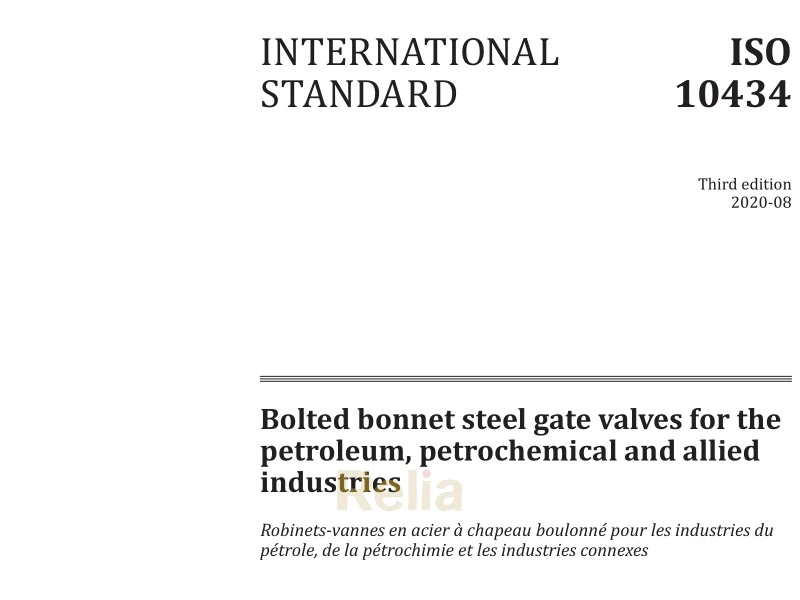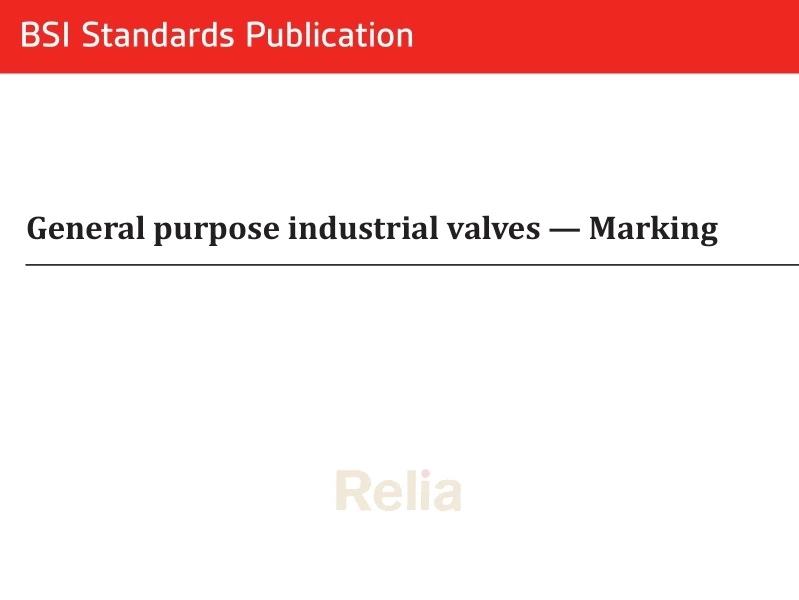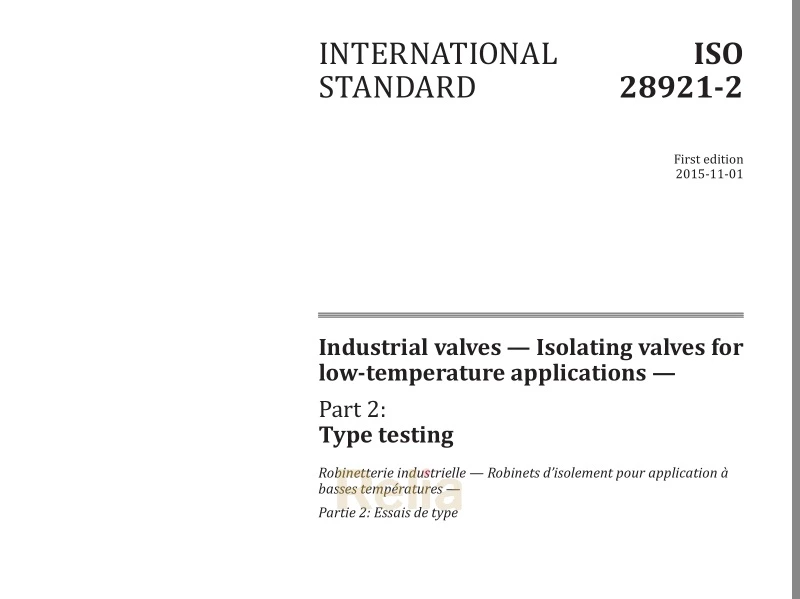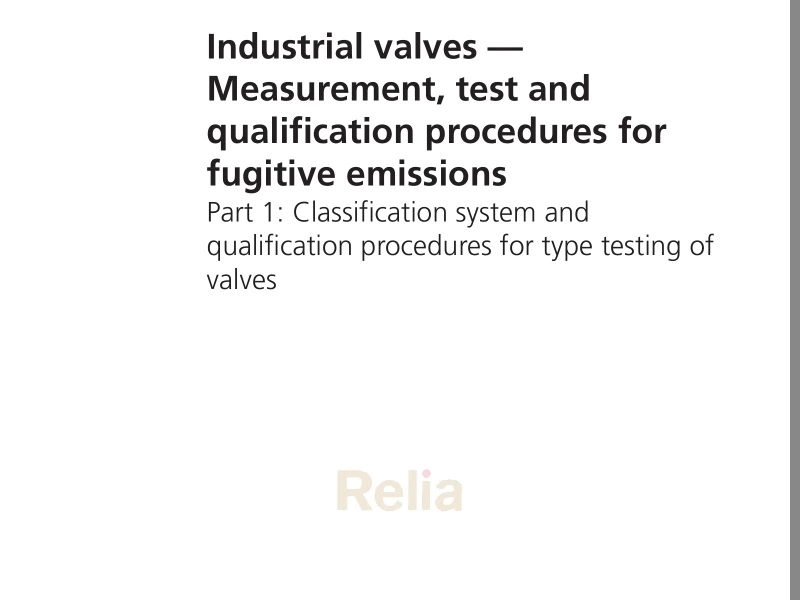ISO 22153: Electric actuators for industrial valves —General requirements
ISO 22153 provides basic requirements for electric valve actuators, used for on-off and control valves. It includes guidelines for classification, design, enclosure and corrosion protection, and methods for conformity assessment.
Combinations of electric actuators and gearboxes when supplied by the actuator manufacturer are within the scope of this document.
ISO 22153 does not cover solenoid actuators, electro-hydraulic actuators and electric actuators which are integral to the valves.
Other requirements or conditions of use different from those indicated in this document are agreed between the purchaser and the manufacturer/supplier, prior to order.
4 Classification —Designation
4.1 General
Electric valve actuators are classified per type, duty and action on loss of external electric power as detailed below.
4.2 Type
There are three types of actuators:
一 part-turn actuator;
一 multi-turn actuator;
— linear actuator.
4.3 Actuator duty classification
The basic design requirements for electric actuators duty classification are given in Table 1.
The electric actuator shall be designed to meet the endurance criteria defined in Table 2, Table 3 or Table 4.
Table 1 —Duty classification
| Class | Duty | Definition |
| A | On-off | The electric actuator is required to drive the valve through its stroke from the fully open position to the fully closed position or vice-versa. |
| B | Inching/positioning | The electric actuator is required to occasionally drive the valve to any position (fully open, intermediate and fully closed). |
| C | Modulating | The electric actuator is required to frequently drive the valve to any position between fully open and fully closed. |
| D | Continuous modulating | The electric actuator is required to continuously drive the valve to any position between fully open and fully closed. |
4.4 Action on loss of external electric power
4.4.1 Stay put action
On loss of external power, the actuator remains in the position achieved before loss of power.
4.4.2 Fail-safe action
4.4.2.1 Electric fail-safe action
On loss of external power, the actuator is able to operate the valve to a predefined position using stored electrical energy.
4.4.2.2 Mechanical fail-safe action
On loss of external power, the actuator is able to operate the valve to a predefined position using stored mechanical energy.
Table 2—Part-turn actuators endurance test requirements (see Annex A )
| Rated torque ranges a Nm | Class A and B On-Offinching (number of cycles) b | Class C Modulating (number of starts) | Class D Continuous modulating (number of starts) c |
| Up to 125 | 10000 | 1800000 | 10000000 |
| 126-1000 | 10000 | 1200000 | 10000000 |
| 1001-4000 | 5000 | 500000 | 5000000 |
| 4001-32000 | 2500 | 250000 | T.B.A.d |
| Above 32000 | 1000 | T.B.A.d | T.B.A.d |
a Based on ISO 5211.
b One cycle consists of nominal 90°angular travel in both directions (ie.90°to open and 90°to close). The actuator is able to transmit 100 %of the rated torque for at least 4, 5°at each end of travel or for at least 9°at either opened or closed position in both directions. The average load cannot be below 30 %of the rated torque for the remaining travel (see Annex C). For angular travel other than 90°, the endurance is agreed between the purchaser and the manufacturer or supplier. During testing a deviation of+20 %and -5 %in load is accepted.
c One start consists of a movement of at least 1 %in either direction, with a load of at least 30 %of the rated torque.
d T.B.A.means to be agreed between manufacturer/supplier and purchaser
Table 3 —Multi-turn actuators endurance test requirements (see Annex A )
| Rated torque ranges a Nm | Maximum allowable thrusta kN | Class A and B On-Off inching (number of cycles) b | Class C Modulating (number of starts) c | Class D Continuous modu- lating (number of starts)c |
| Up to 100 | ≤40 | 10000 | 1800000 | 10000000 |
| 101-700 | ≤150 | 10000 | 1200000 | 10000000 |
| 701-2500 | ≤325 | 5000 | 500000 | 5000000 |
| 2501-10000 | ≤1100 | 2500 | 250000 | T.B.A.d |
| Above 10000 | >1100 | 1000 | T.B.A.d | T.B.A.d |
a Based on ISO 5210.
b One cycle consists of 25 turns in both directions (i.e.25 turns to open and 25 turns to close). The actuator is able to transmit 100 %of the rated torque for at least 2, 5 turns at the closed position in both directions. The average load cannot be below 30 %of the rated torque for the remaining travel (see Annex C). During testing a deviation of+20 %and -5 %in load is accepted.
c One start consists of a movement of at least 1 %of travel in either direction, with a load of at least 30 %of the rated torque.
d T.B.A.means to be agreed between manufacturer/supplier and purchaser.





